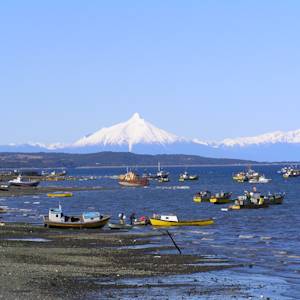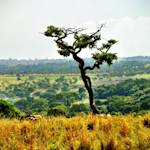The Great Arctic Reserve
1993 CE • Russia
"Above the Arctic Circle, the Taimyr Peninsula and the waters that surround it – the Karsk and Laptev Seas – are so remote that vast expanses of wilderness remain virtually untouched by human beings. This realm of tundra and arctic desert is home to polar bear and reindeer, walrus and beluga. The brief summers are crucial nesting times for many migratory birds that winter in warmer climates. Since 1993, these and other animals have received official protection in Russia's largest protected area, Bolshoi Arktichesky ("Great Arctic") Zapovednik [the Russian term for reserve] . . . Few mammals can survive the harsh polar climate of Great Arctic Zapovednik, but there are notable exceptions to this rule. Though endangered, [polar bears] are relatively common here, preferring the islands and coastal areas," and Arctic foxes "can regularly be seen following polar bears to scavenge the remains of the bears’ meals. A continuous population of [reindeer], which varies from 50,000 to 150,000 individuals each summer, can be found throughout the reserve, taking advantage of different landscapes during various times of the year." Lemmings, seals, beluga whales, walruses, and musk oxen can also be found throughout the park . . . The idea to found Great Arctic Zapovednik was born in 1989 on a joint Soviet-German scientific expedition to Taimyr. Four years later, after extensive research and preparation by Russian and international scientists, the zapovednik was founded, the largest to date in Russia . . . Scientific research has a significant history in the region and continues to be an important function of the zapovednik. Polar research stations have been established in several areas of the zapovednik and numerous Russian and international research projects continue to increase knowledge and understanding of arctic ecosystems."
Lisa Woodson, "Great Arctic Zapovednik," Center for Russian Nature Conservation.
Image: GRID-Arendal via Flickr, Attribution-NonCommercial-ShareAlike 2.0 Generic (CC BY-NC-SA 2.0)


Learn about Maya Lin’s fifth and final memorial: a multi-platform science based artwork that presents an ecological history of our world - past, present, and future.

Discover ecological histories and stories of former abundance, loss, and recovery on the map of memory.

Learn how we can reduce our emissions and protect and restore species and habitats – around the world.

See how art can help us rethink the problems we face, and give us hope that each one of us can make a difference.

Help make a global memorial something personal and close to home. Share your stories of the natural world.


